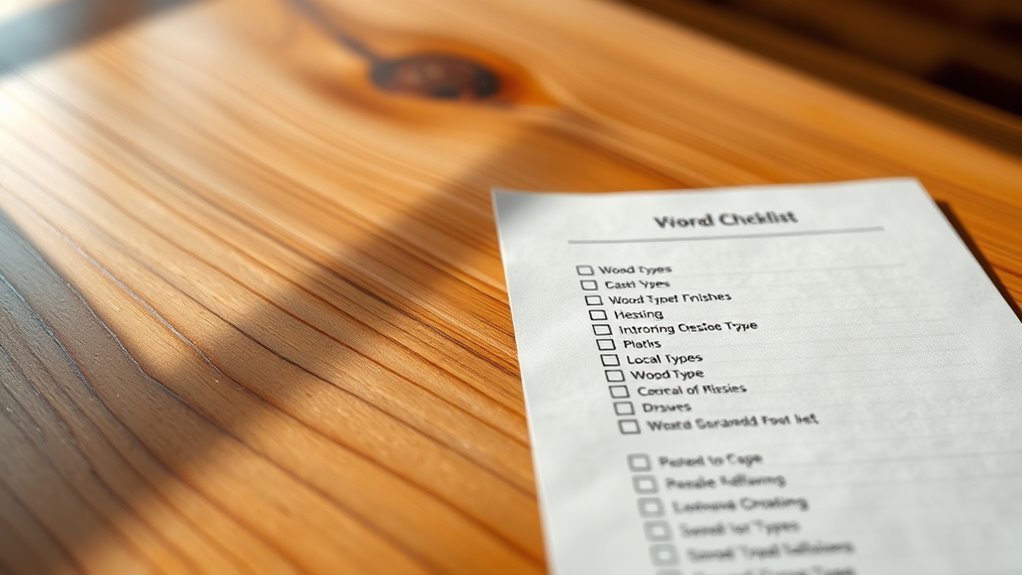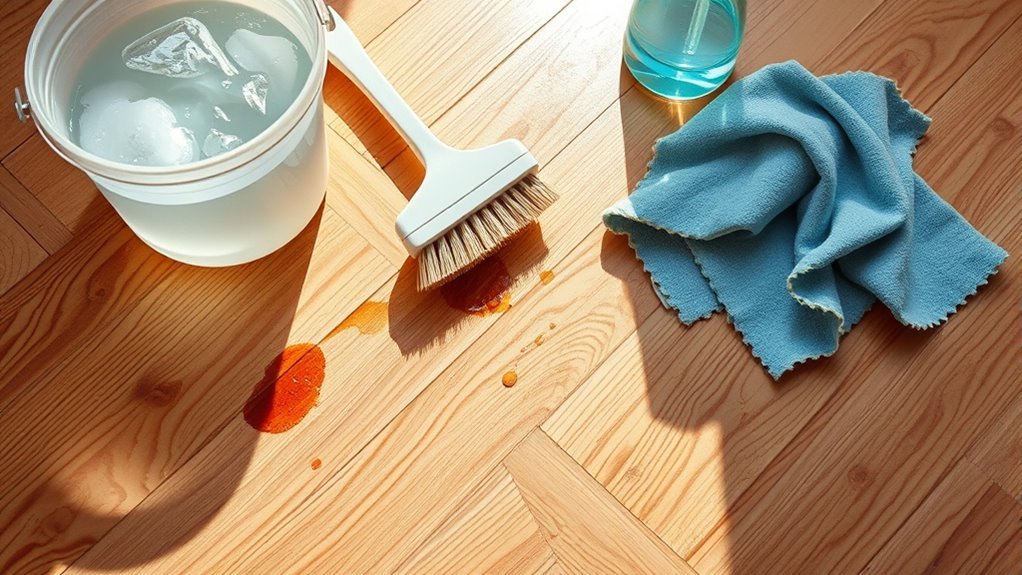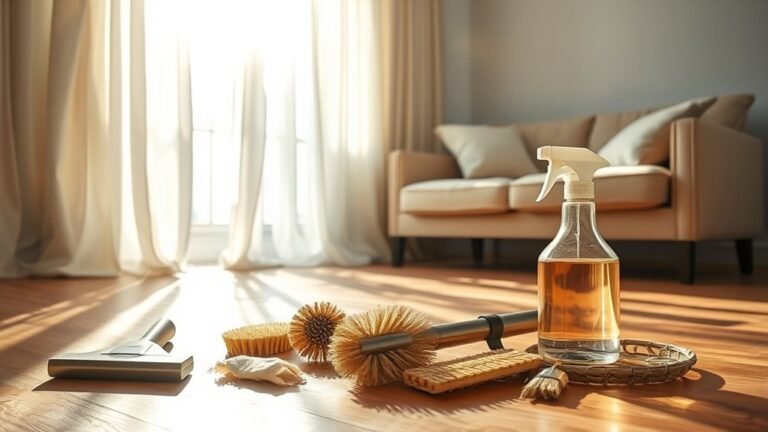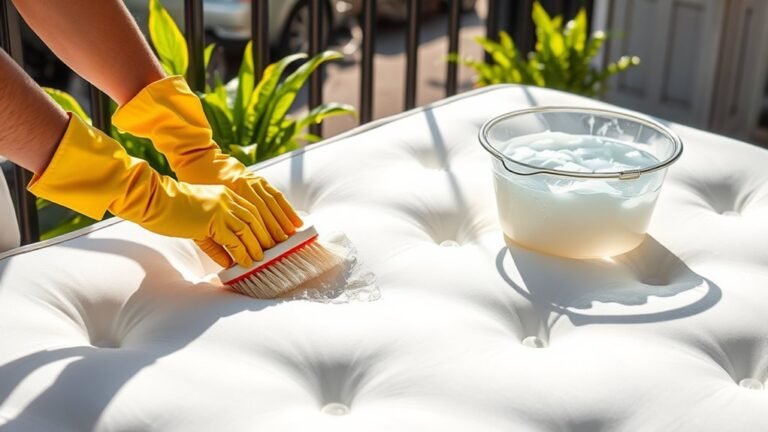Deep Cleaning Checklist for Wood
To deep clean your wood, first identify its type and finish to choose safe products. Gather soft cloths, brushes, and mild, wood-specific cleaners. Start by removing dust with a microfiber cloth and soft brush. Use a gentle cleaning solution, testing it in a hidden spot, and clean stains carefully with baking soda paste or mild detergent. Dry thoroughly, then polish with appropriate polish and apply protective sealants in thin, even layers. Stick around to uncover more essential care steps for lasting wood beauty.
Assessing the Type of Wood and Finish

Understanding the type of wood and its finish is essential before beginning any deep cleaning process. Different wood types, such as oak, maple, or walnut, respond uniquely to cleaning methods. You’ll want to identify if the wood is soft or hard, as softer woods require gentler care to prevent damage. Additionally, finish differences play a critical role; finished woods might have polyurethane, varnish, or oil coatings, each demanding specific cleaning solutions and techniques. For instance, oil finishes absorb moisture differently than sealed finishes, meaning you must avoid harsh chemicals that could strip protective layers. By accurately evaluating both wood types and finish differences, you guarantee your cleaning approach preserves the wood’s integrity, letting you maintain its natural beauty without restriction.
Gathering Essential Cleaning Supplies
Before you start cleaning, make sure you have the right tools like soft cloths, brushes, and microfiber towels. Choose cleaning solutions that are specifically designed for your wood type and finish to avoid damage. Don’t forget protective gear such as gloves and masks to keep yourself safe during the process.
Must-Have Cleaning Tools
To tackle deep cleaning wood effectively, you’ll need at least five essential tools that guarantee thorough care without damaging the surface. Choosing eco friendly products alongside the right cleaning tools frees you from harsh chemicals while preserving your wood’s natural beauty. Here’s what you shouldn’t be without:
- Soft microfiber cloths to gently lift dirt without scratching
- A natural bristle brush for crevices and textured grain
- A vacuum with a brush attachment to remove dust deeply
- A spray bottle for applying eco friendly cleaning solutions evenly
- A sturdy sponge that’s absorbent yet non-abrasive
With these tools, you can confidently deep clean wood surfaces, maintaining their integrity and charm. They’re your allies in preserving freedom from damage while embracing sustainability.
Best Cleaning Solutions
Once you’ve gathered the right tools, selecting the best cleaning solutions is the next step to protect and enhance your wood surfaces. You’ll want to choose products that effectively clean without damaging the wood’s finish. Eco friendly options like diluted vinegar or gentle castile soap are excellent for daily maintenance, offering a natural way to lift grime and preserve the wood’s integrity. When tackling tougher stains, commercial solutions formulated specifically for wood can provide powerful results without harsh chemicals. Always check product labels to verify compatibility with your wood type. Avoid anything abrasive or overly alkaline, as these can strip protective coatings. By carefully selecting your cleaning solutions, you maintain your wood’s beauty and longevity while enjoying the freedom of a fresh, spotless surface.
Protective Gear Essentials
Three key pieces of protective gear you’ll need when deep cleaning wood are gloves, goggles, and a mask. Rubber gloves shield your hands from harsh chemicals and splinters, while safety goggles protect your eyes from dust and cleaning solution splashes. Wearing a mask prevents inhalation of fine particles and fumes, keeping your lungs safe.
To prepare effectively, gather these essentials:
- Durable rubber gloves for chemical resistance
- Clear safety goggles for unobstructed vision
- A well-fitting mask to filter dust and vapors
- Comfortable clothing that covers your skin
- Non-slip footwear to maintain steady footing
Removing Surface Dust and Debris
Although it might seem simple, removing surface dust and debris is an essential first step in deep cleaning wood, as it prevents scratches and guarantees better absorption of cleaning products. Start with a soft microfiber cloth or a feather duster to gently lift dust without grinding particles into the wood grain. For corners and crevices, use a soft-bristled brush to dislodge trapped debris. Avoid harsh sweeping motions that can push dust deeper. Consistent dust removal supports surface maintenance by preserving the wood’s natural finish and preventing buildup that dulls its appearance. By thoroughly clearing away loose dirt, you create an ideal foundation for subsequent cleaning steps, ensuring your wood surfaces stay vibrant and protected while freeing you to enjoy a well-maintained space.
Preparing the Cleaning Solution

You’ll want to choose cleaning ingredients that are gentle yet effective, avoiding harsh chemicals that can damage wood fibers or finishes. Carefully measure and mix your solution according to recommended ratios to guarantee maximum cleaning power without oversaturation. Using proper mixing methods helps maintain the solution’s stability and protects your wood surfaces during the deep cleaning process.
Selecting Safe Cleaning Ingredients
Choosing the right cleaning ingredients is essential to maintain the integrity and finish of your wood surfaces. You want to avoid harsh chemicals that can damage wood or strip its natural oils. Instead, focus on eco-friendly options that guarantee ingredient safety for both your home and the environment. When selecting ingredients, consider the following:
- Use mild, plant-based soaps to gently lift dirt without harm
- Avoid ammonia or bleach, which can discolor or weaken wood
- Choose natural oils like lemon or olive to nourish and protect
- Opt for biodegradable ingredients that won’t pollute waterways
- Prioritize products labeled specifically safe for wood finishes
Mixing Ratios and Methods
Proper mixing ratios and methods are essential for preparing an effective and safe cleaning solution for your wood surfaces. Start by measuring ingredients accurately—too strong a solution can damage wood, while too weak won’t clean properly. For example, a common ratio is one cup of mild detergent or wood cleaner per gallon of warm water. Always dilute concentrated cleaners according to the manufacturer’s instructions to maintain correct mixing ratios. When combining ingredients, add liquids slowly while stirring gently to guarantee even distribution without creating excess foam. Use a soft cloth or sponge to apply the solution evenly, following gentle cleaning methods that protect the wood’s finish. By mastering precise mixing ratios and cleaning methods, you maintain your wood’s integrity while achieving a thorough, safe deep clean.
Techniques for Deep Cleaning Wood Surfaces
Although wood surfaces require gentle care, there are effective techniques you can use to deep clean them without causing damage. Proper wood care hinges on using the right methods that respect the material’s nature while ensuring thorough cleanliness. Here are essential maintenance tips to keep your wood surfaces vibrant and protected:
- Use a soft cloth dampened with a mild soap solution to remove dirt.
- Avoid excessive water; always wring out cloths to prevent warping.
- Gently scrub with a soft-bristle brush for crevices and grain.
- Dry surfaces immediately with a clean, dry cloth to prevent moisture buildup.
- Apply natural oils or waxes after cleaning to nourish and seal the wood.
Following these techniques lets you maintain your wood’s beauty while granting you the freedom to enjoy its warmth and character.
Tackling Stubborn Stains and Spots

When you encounter stubborn stains and spots on your wood surfaces, addressing them promptly is crucial to prevent permanent damage. Start with spot cleaning using a soft cloth dampened with a mild detergent solution; test in an inconspicuous area first to verify no discoloration. For tougher stains, consider a mixture of baking soda and water applied gently to the affected area—avoid abrasive scrubbing that can damage the wood grain. You can also use specialized wood stain removal products designed for your wood type, following manufacturer instructions carefully. Always blot stains rather than rubbing, which spreads them. By tackling stains immediately and with appropriate techniques, you maintain the wood’s integrity and appearance, guaranteeing your deep cleaning efforts yield lasting results without compromising the natural beauty of the wood.
Drying and Polishing the Wood
Once you’ve thoroughly cleaned the wood surface, it’s essential to dry it completely to prevent moisture damage and prepare it for polishing. Proper wood drying guarantees your efforts last and the wood’s integrity remains intact. Use a soft, lint-free cloth to absorb residual moisture, and allow the wood to air dry in a well-ventilated space.
When you’re ready to polish, follow these polishing techniques to elevate the wood’s natural beauty:
- Choose a polish suited for your wood type
- Apply in thin, even layers
- Use circular motions to enhance shine
- Avoid over-polishing to prevent buildup
- Buff gently with a clean cloth for a smooth finish
Mastering wood drying and polishing techniques frees you to maintain your wood’s lifelike warmth and elegance.
Applying Protective Treatments and Sealants
Before you finish your deep cleaning process, applying protective treatments and sealants is essential to safeguard the wood from moisture, stains, and wear. Start by selecting the appropriate wood preservation methods based on your wood type and exposure conditions. You’ll want to focus on sealants that penetrate deeply, offering long-lasting protection without compromising the wood’s natural look. When it comes to sealant application techniques, confirm the surface is completely dry and clean. Use a high-quality brush or a lint-free cloth to apply the sealant evenly, following the wood grain for consistent coverage. Allow adequate drying time between coats, usually two to three, to build a durable barrier. This careful approach helps maintain your wood’s beauty and extends its lifespan, giving you freedom from constant maintenance.
Häufig gestellte Fragen
How Often Should I Deep Clean My Wood Furniture?
You should aim for a deep cleaning frequency of at least twice a year to keep your wood furniture in top shape. Furniture maintenance tips suggest regular dusting and immediate spill cleanup to prevent damage between deep cleans. If your pieces face heavy use or environmental factors like sunlight and humidity, consider increasing deep cleaning to every three months. This routine helps preserve the wood’s finish, ensuring your furniture stays beautiful and lasts longer.
Can Deep Cleaning Damage Antique Wood Pieces?
Did you know over 60% of antique wood damage results from improper cleaning methods? When it comes to antique care, deep cleaning can indeed cause harm if you’re not careful. You shouldn’t use harsh chemicals or abrasive tools, as they can strip finishes or weaken delicate wood fibers. Instead, stick to gentle, specialized products and techniques designed for antiques, preserving their character while giving you the freedom to maintain them safely.
Is It Safe to Use Vinegar on All Wood Types?
You shouldn’t use vinegar on all wood types since its acidity can damage some wood finishes, especially delicate or antique ones. Instead, opt for vinegar alternatives like diluted mild soap or specialized wood cleaners that protect the finish. Always test any cleaner on a hidden spot first. By choosing the right solution, you preserve your wood’s beauty and enjoy the freedom to clean without risking harm to your treasured pieces.
How Do I Prevent Wood From Warping During Cleaning?
You might worry that avoiding warping means you have to baby your wood constantly, but it’s really about smart moisture control and temperature regulation. Keep water use minimal—damp cloths, not soaking—and dry surfaces promptly. Avoid extreme temperature swings; don’t clean wood in direct sunlight or near heaters. By managing moisture and temperature carefully, you’ll protect your wood’s natural freedom and beauty without sacrificing thorough cleaning or durability.
What Are the Best Tools for Cleaning Intricate Wood Carvings?
When cleaning intricate wood carvings, you’ll want to use specialized brushes like soft-bristle toothbrushes or small artist brushes to reach tight spots without damaging details. Pair these with gentle, wood-safe cleaning solutions—avoid harsh chemicals to protect the finish. You can also use cotton swabs dipped lightly in the solution for precision. These tools let you clean thoroughly while preserving the carving’s beauty, giving you the freedom to maintain your woodwork confidently.






